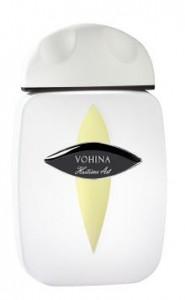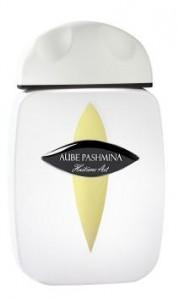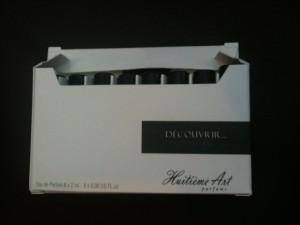Pierre Guillaume is one of the most prolific and creative perfumers working. When I heard he was creating a new line of fragrance where he would utilize a new extraction method. He would attempt to showcase these new materials and create a line of eight new fragrances.
He waxed quite elegantly about his motivations and what he hoped to accomplish with these Huitieme Art Parfums in his interview with Editor-In-Chief Michelyn Camen. After having lived with them for the last week I can confidently state the new extraction technique makes a huge difference in how I experienced what I previously thought were familiar notes. Also in the interview, M. Guillaume mentioned that the Huitieme Art Parfums line of fragrances did not hew to a traditional fragrance pyramid. My experience is that all of the Huitieme Art Parfums fragrances are “linear”. Usually that is a word one doesn’t want associated with their fragrance. In this case I think M. Guillaume will relish this. In many ways all of the fragrances in this line are examples of what phyto-perfumery can be in the most basic sense. I liken it to what a painter must feel like when they hear a new oil color is available. All of a sudden the creative opportunities are widened. Each of these fragrances is meant to show what phyto-perfumery can do. The next step will be to see where phyto-perfumery can go. I want to give each one of these fragrances their due and so the reviews of all eight fragrances are going to be split into two parts. In Part 1 I’ll review Ciel D’Airian, Vohina, Aube Pashmina, and Manguer Metisse.
Ciel D’Airian
In his interview M. Guillaume mentioned that in Ciel D’Airian he wanted to explore the new phyto-perfumery by taking a note and fully exploring it. He likened this exploration to what happened when Dyptique Philosykos and L’Artisan Premier Figuier first appeared sporting the, then, new fig accord. Ciel D’Airian might be the bellweather for another fruit note, pear. After recently trying Jo Malone English Pear & Freesia I was attuned to this accord and in that fragrance I thought it was very well done. Then I sprayed Ciel D’Airian on a strip and was surrounded by a real live pear hanging on the tree. The lush fruit with a slight hint of wood is breathtakingly life-like on my skin. I get the bark of the tree along with the ripe fruit, underneath is a foundation of ambergris. The other listed note is olive tree branch but it must be melded into the overall pear accord. In Ciel D’Airian, M. Guillaume shows how phyto-perfumery takes a note like pear and adds more intensity and nuance. When next we meet I look forward to it having some more playmates.
Vohina
Vohina’s three notes are peach blossom, lavender honey, and hay. In this fragrance it is the lavender honey which comes alive. The peach blossom lilts across the early moments but the sweet lavender honey arrives almost simultaneously with the sweet hay. There is a decadent sweetly floral core at work here and, as in Ciel D’Airian, it is the possibility of what it could be used in that excites me most. Vohina will be one of the most overlooked in the line because it smells the most familiar but as with the pear note the nuances on display are what this new technique seems to enhance.
Aube Pashmina
If Vohina will be overlooked because it is the most familiar; Aube Pashmina will be overlooked because it is the most unusual fragrance of the eight. Aube Pashmina feels the most experimental from a construction viewpoint as well as the ingredients. It is a garden milieu led by tomato leaf, basil and rosemary along with geranium and cassis berry. When I first smelled this on a strip I felt like there was jasmine and orange blossom present. Once I looked at the ingredients it turned out to be a new note, satinwood, which is described as having a “jasmine-orange vibration”. This note shows the how far this technique can expand a perfumer’s horizons. The satinwood extract adds a sweetly floral component that I don’t think would be possible via addition of the notes separately. It enhances this lovely backyard garden milieu. I can almost see the garden table set with a vase of jasmine, geranium, and orange blossom with a plate of heirloom tomatoes covered with basil accompanied by a blackcurrant dessert. It is a marvelous summer harvest fragrance.
Manguier Metisse
While I liked and admired the possibility inherent in the first three Huitieme Art Parfums the one that just slayed me was Manguier Metisse. When I compared notes with Michelyn I found that she also was spraying herself with Manguier Metisse regularly, too. Manguier Metisse is just two notes; the phyto-perfumery extract of mango married with frangipani. If there is going to be a breakout note from this first set of phyto-perfumery extracts my money is on this mango accord. Most often the mango accord we get in fragrance is that of green mango, slightly unripe and tart. This mango extract is the opposite of that as it carries a fully ripened character. It has a density that puts all previous mango accords in its rearview mirror. The frangipani is just the perfect companion as the sweetly floral note creates a fragrant synergy that showcases the mango to its fullest extent. Manguier Metisse is so lush it comes off almost gourmand on my skin as opposed to fruity floral. It is one of my two favorite fragrances from this line.
All Huitieme Art Parfums fragrances have above average longevity and average sillage.
Four down, four to go; Part 2 will be posted on Monday October 4th.
Disclosure: This review was based on preview samples from Hutieme Art Parfums.
Now a lucky Ca Fleure Bon reader will also get to discover the “Huitième Art Parfums" line. Thanks To Pierre, we are giving away The Decouvrir kit, which contains 2ml spray of each fragrance. We will draw from among all comments on this article, the interview by Michelyn Camen and Part 2 of the review on October 4th. The draw will take place on Wednesday October 6 at 11:59 PM EST.
You must leave a comment on Cafleurebon.com to be eligible.
-Mark Behnke, Managing Editor







